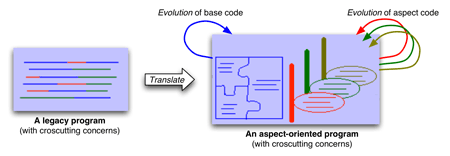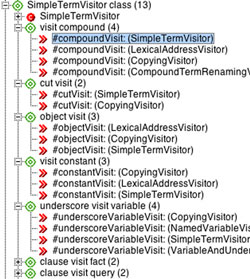|
|||||
Aspect-Oriented Software Evolutionby Tom Mens, Kim Mens and Tom Tourwé All software systems are subject to evolution. This poses great challenges for software engineers. Aspect-oriented software development (AOSD), in addition to separating the different concerns during software development, can be seen as a way of overcoming many of the problems related to software evolution. At the same time, AOSD may benefit from tools and techniques that automate software evolution. ERCIM members are therefore exploring the cross-fertilisation between these two active research domains. Real-world software needs to evolve continually in order to cope with ever-changing software requirements. Manny Lehman identified this characteristic in his so-called first law of software evolution, which addresses continuing change: a program that is used must be continually adapted else it becomes progressively less satisfactory. This need for software to evolve continuously poses important challenges for software engineers. Advanced automated software engineering techniques and tools are needed to improve software evolution support. An ERCIM Working Group on Software Evolution is currently being formed to address this need. Two important techniques that will be investigated are software restructuring and aspect-oriented software development. Software Restructuring In program transformation research, two different restructuring approaches can be distinguished. The term rephrasing is used to refer to techniques that improve the structure of the software without changing the implementation language. A typical example is software refactoring, which tries to improve the internal structure of a program without changing its external behaviour. The term 'translation' refers to techniques that restructure the software across programming languages. A typical example is migration of legacy code to an object-oriented equivalent (eg COBOL to Java). An essential problem with software development is the tyranny of the dominant decomposition. No matter how carefully a software system is decomposed into modular units, there will always be concerns (typically non-functional ones) that cut across the chosen decomposition. The code of these crosscutting concerns will necessarily be spread over different modules, which has a negative impact on the software quality in terms of comprehensibility, adaptability and evolvability. Aspect-oriented software development (AOSD) has been proposed as a solution to this problem. In order to capture cross-cutting concerns in a localised way, a new abstraction mechanism (called an aspect) is added to existing programming languages (eg AspectJ for Java). As a result, cross-cutting concerns are no longer distributed over different modules. This means the software is easier to maintain, evolve and understand. Cross-fertilisation
Our research investigates how formal techniques, successful in supporting traditional software evolution, can support these three new activities. For example, in a recent experiment, we used formal concept analysis to mine for cross-cutting concerns in object-oriented source code. With this approach we detected interesting features corresponding to cross-cutting functional or non-functional concerns, as well as occurrences of design patterns like the Visitor design pattern (see Figure 2). Typically, the implementation of such a pattern spans multiple classes and methods, and grouping these in a single hierarchical view allows the developer to understand and manipulate the pattern more easily.
In another experiment we dealt with aspect introduction and aspect evolution. More specifically, we investigated how evolution of the base code affects the definition of aspects that work on it. In order to address this issue, we proposed a more sophisticated aspect-oriented programming language, accompanied by an advanced development environment. The environment helps a developer to define aspects as logic rules, and is able to assess the impact of evolution on these aspects automatically. To this extent, the environment relies on a machine learning algorithm called inductive logic programming. European Collaboration
Please contact: |
|||||




